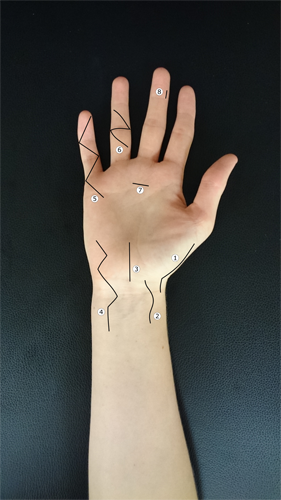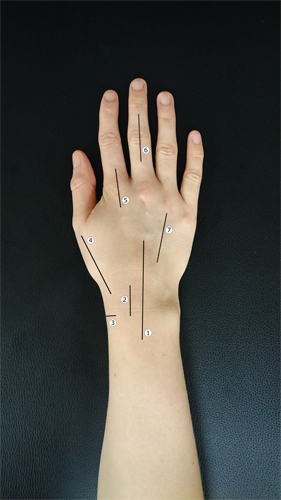Look
Put the hands next to each other in a similar position and start inspection on the dorsum of the wrist. Look for obvious swellings, deformities or scars. Is the deformity unilateral or bilateral?
Ask the patient to supinate and assess the volar wrist.
Finally ask the patient to flex their elbows and show you the ulnar aspect of their wrists and the extensor surface of their forearms.
Deformities to look for:
Scars
Rheumatoid arthritis
- Bilateral with multiple joint involvement
- Diffuse dorsal swelling/ synovitis
- DRUJ subluxation
- Dorsal prominence of the ulnar head
- Asymmetry when assessing the ulnar border of the wrists with elbows flexed
- Ulnar and volar subluxation of the carpus
- Other findings to note:
- Radial metacarpal drift/ ulnar deviation of the fingers
- Extensor tendon rupture/ Vaughan-Jackson syndrome
- Flexor tendon rupture
- Finger deformities
- Rheumatoid nodules
Radial malunion
- Radial shortening
- Prominent ulna
Madelung’s deformity
- Defective development of the volar/ulnar distal radial physis
- Volar radial bowing with a dorsally prominent distal ulna
- Can be bilateral in up to 60%
- Called a ‘reverse Madelung’s deformity’ where there is dorsal radial bowing
Wrist ganglion
- Most commonly dorsal, overlying the scapholunate ligament
Carpal boss
- (normally) painless bony prominence at the base of the second and third metacarpals
- Tends to be more distal than dorsal ganglia
Muscle wasting

Figure 1.Volar scars 1.Wagner(a)Trapeziectomy (b) Bennett fracture 2 Scaphoid 3 Carpal tunnel 4 Guyon’s canal 5 Brunner (a)Dupuytren’s (b)Flexor tendon repair 6 Z-plasty (a)Scarring (b)Dupuytren’ 7 Trigger finger release 8 Combined with (7): flexor tendon sheath washout

Figure 2.Dorsal scars 1.Midline dorsal (a)Fusion (b)Synovectomy (c)Carpal ligament repair (d)1+3+4: EIP to EPL transfer 2 Dorsal to scaphoid (a)Proximal pole fractures (b)Ligament repair 3 De Quervain’s release 4 Radiopalmar to thumb base (a)Trapeziectomy (b)Bennett fracture 5 Dorsal to MCPJ 6 Dorsal to IPJ (a)Tendon repair (b)Arthroplasty (5)Dorsal to metacarpal (a)Fracture fixation